Our series on the Divine Liturgy resumes.
On Lenten Sundays we celebrate the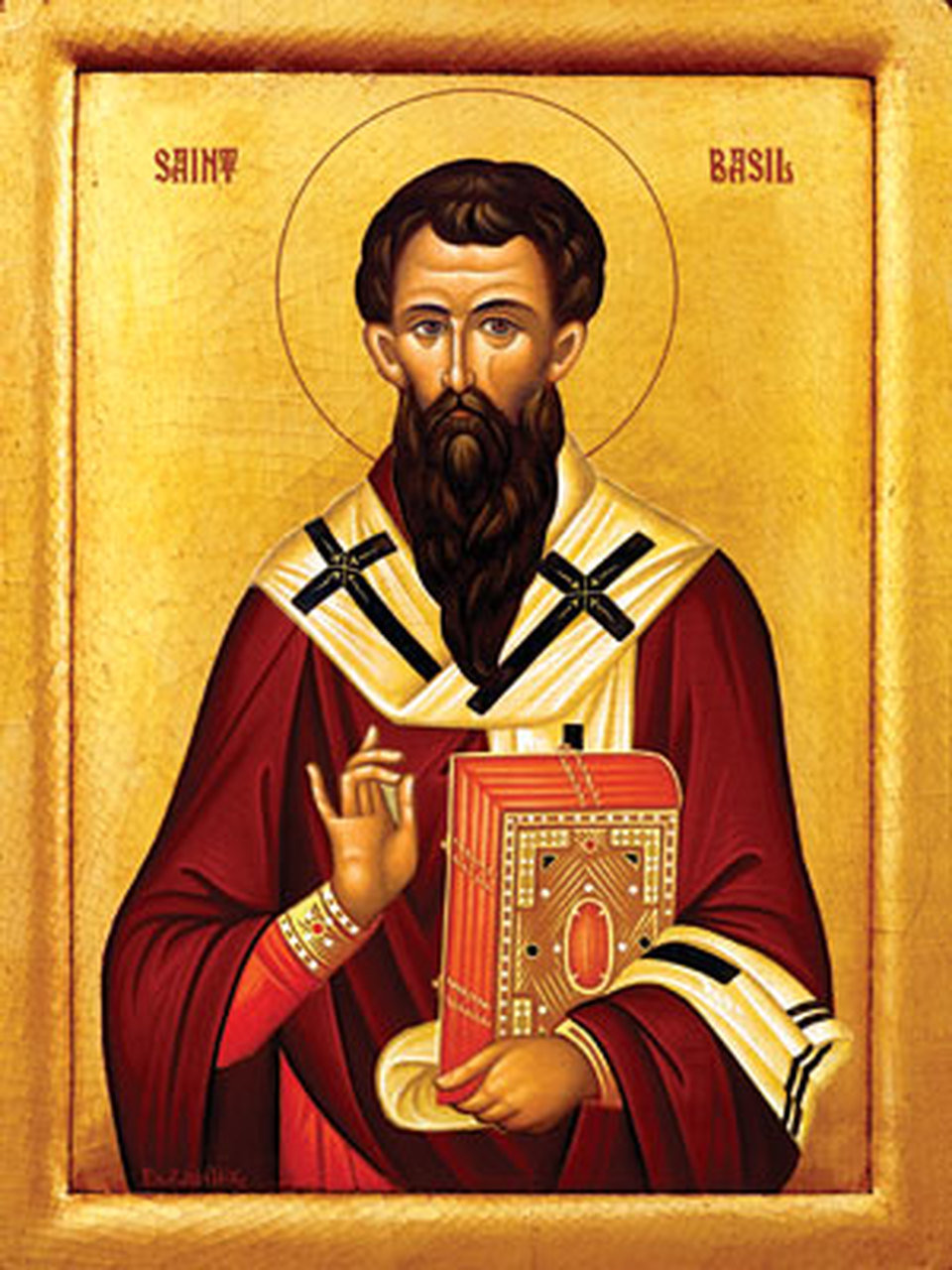 Liturgy of Saint Basil, so I’ve been saving his Anaphora for now. As you’ll remember, “Anaphora” (αναφόρηση) means “offering” – the final part of the Liturgy when we offer the Holy Gifts, the Bread and Wine. Basil here gave us the most succinct summary I know of our Orthodox understanding of salvation history. It’s also a gorgeous piece of writing.
Liturgy of Saint Basil, so I’ve been saving his Anaphora for now. As you’ll remember, “Anaphora” (αναφόρηση) means “offering” – the final part of the Liturgy when we offer the Holy Gifts, the Bread and Wine. Basil here gave us the most succinct summary I know of our Orthodox understanding of salvation history. It’s also a gorgeous piece of writing.
Previous Posts in this series are 151, 152, 163-165. I’ve discovered that the simple way to find them is to Google (or whatever) “Ancient Faith Blogs Father Blll 151”, etc.
The text of Saint Basil’s Liturgy is found in some prayer books, or maybe you can borrow a copy at your church. On line: https://www.goarch.org/-/the-divine-liturgy-of-saint-basil-the-great
In what follows, I’ll use texts from my own Antiochian Orthodox Archdiocese, simply because that’s what I’m accustomed to.
You’ll recall that during the Proskomidia (Posts 51, 52) before 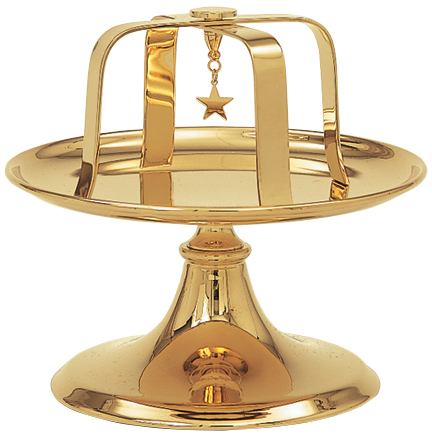 Divine Liturgy, the Priest “constructed” on the Diskos an image of the Church:
Divine Liturgy, the Priest “constructed” on the Diskos an image of the Church: 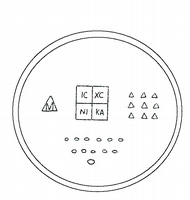 Christ in the center, the Holy Theotokos and the categories of Saints on the sides. At the bottom he placed particles of the Bread, each representing 1) the Bishop and other persons important to himself, 2) persons requested by those who provided the Prosphora, 3) others for whom prayers have been requested. Since Saint Nicholas, Cedarburg, is a small church, we include all our members, both living and departed.
Christ in the center, the Holy Theotokos and the categories of Saints on the sides. At the bottom he placed particles of the Bread, each representing 1) the Bishop and other persons important to himself, 2) persons requested by those who provided the Prosphora, 3) others for whom prayers have been requested. Since Saint Nicholas, Cedarburg, is a small church, we include all our members, both living and departed.
The Great Entrance
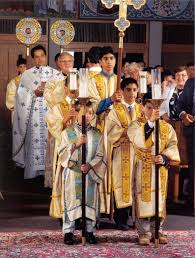 Now, accompanied by Cross, fans, candles and incense the
Now, accompanied by Cross, fans, candles and incense the  Priest carries these Holy Gifts through the church – out the north door of the Altar, down the north aisle, back up the main aisle through the congregation and finally through the Royal Doors into the Altar. In symbol the Priest “picks up” each of us and our needs and cares, and carries us to the Altar, while the Cherubic Hymn is sung:
Priest carries these Holy Gifts through the church – out the north door of the Altar, down the north aisle, back up the main aisle through the congregation and finally through the Royal Doors into the Altar. In symbol the Priest “picks up” each of us and our needs and cares, and carries us to the Altar, while the Cherubic Hymn is sung:
Before he enters the Altar, he offers in prayer the names of those who have given the Prosphora and those for whom they have asked prayers, as well as others.
Then the Priest passes through the Royal Doors. In symbol, the Little Entrance carried us to the “lower Heaven”. (I don’t know how else to say this: see 2 Corinthians 12:2-4.) This Great Entrance leads us to the “Highest Heaven”, to the Altar of God and the Eternal Offering of Jesus Christ. He places us on that Altar table, to be offered to the Father through Jesus Christ our Lord, by the power of the Holy Spirit.
A Litany then follows. Why? I don’t know. It interrupts the flow. My guess is that during the early years, Litanies were inserted into Orthodox services in order to give the Priest and cantor a chance to catch their breath before whatever comes next! I could be wrong.
The Exchange of Peace and the Creed
The reciting of the Creed was (by Orthodox standards) one of the last additions to the Liturgy – late Fifth Century. It plays a different function for us than it does in the West. You can tell this by where it is placed. In the West the Creed is preceded by the Scripture readings, to which it seems to be chiefly an affirmation of the teaching. In the Orthodox Liturgy, the Creed is preceded by the words “Let us love one another, that with one accord we may confess: Father, Son and Holy Spirit, the Trinity, one in essence and undivided”, and the Exchange of Peace. Without love for each other, we cannot grasp the Faith. Love is primary. Not doctrine. The Creed is an affirmation of faith in God. The Creed begins “I believe in…”, not “I believe that there is…”
In the early Church, all exchanged the Peace. Then for many centuries it was limited to the clergy – I don’t know why. Now the 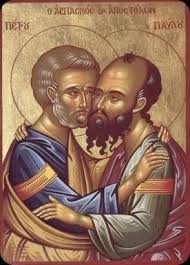 people sometimes participate again. Some years ago our Antiochian Metropolitan Philip (+ memory eternal) directed this, and at Saint Nicholas it now seems a very natural thing to do. * Also significant theologically: Christ is present not only in His Body the Holy Eucharist, but also in His Body the Church, in the people around us. That is why at the Peace we Orthodox say “Christ is in our midst.” “He is and shall be.” Our people need to be taught that the Peace is not a social exchange. Long ago, before I was Orthodox, I visited a Eucharistic service in a different church. At the Peace I said, properly, to the man next to me “Peace be with you”. He responded “Yeah, how ya doin’?” Please, none of this in the Orthodox Church!
people sometimes participate again. Some years ago our Antiochian Metropolitan Philip (+ memory eternal) directed this, and at Saint Nicholas it now seems a very natural thing to do. * Also significant theologically: Christ is present not only in His Body the Holy Eucharist, but also in His Body the Church, in the people around us. That is why at the Peace we Orthodox say “Christ is in our midst.” “He is and shall be.” Our people need to be taught that the Peace is not a social exchange. Long ago, before I was Orthodox, I visited a Eucharistic service in a different church. At the Peace I said, properly, to the man next to me “Peace be with you”. He responded “Yeah, how ya doin’?” Please, none of this in the Orthodox Church!
- As much as we Orthodox love hugging and kissing, please, please till the coronavirus crisis is over, keep your distance from each other. Even an elbow bump is too close.
Next, the Deacon sings the oddest thing: “The Doors! The Doors! In wisdom, let us attend.” Why ever? Anciently, remember, only baptized Christians attended the Anaphora, since how could non-Christians recite the Creed? or offer or receive the Holy Gifts when they didn’t believe in them? So the doorkeepers (ushers in today’s terms) were now told to guard “the doors! the doors!” lest anybody else had got in. (Why does he still sing it today? Because we Orthodox never throw out anything, that’s why.) And then the usual directions to the people when something important is about to happen: “Be wise! Be attentive!”
The Creed follows immediately. Some other time we’ll talk about that.
Have you noticed another odd thing? During the Creed the Priest removes the Aer (the Chalice veil) 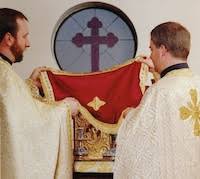 and waves it over the Diskos and Chalice. Why? To keep the bugs off, of course! In ancient times they had no window screens. But why still today?… see the second paragraph above. Right: with two Priests
and waves it over the Diskos and Chalice. Why? To keep the bugs off, of course! In ancient times they had no window screens. But why still today?… see the second paragraph above. Right: with two Priests
Now at last comes…
The Holy Anaphora
The Deacon begins: “Let us stand aright. Let us stand with fear. Let us attend, that we may offer the holy oblation in peace.”
This begins with a dialog between Priest and People. The Priest: “Let us lift up our hearts.” The people: : “We lift them up to the Lord.” Father Alexander Schmemann said these are the most important words of the Divine Liturgy. The Priest began the Liturgy with: “Blessed is the Kingdom of the Father of the Son and of the Holy Spirit”. And from then through the two Entrances, the whole goal of the Liturgy is this: that we be lifted up into God’s Heavenly Kingdom, our true Home. And now, here we are.
Thus far, Saint Basil’s Liturgy has been almost the same as our usual Saint John Chrysostom. Now things change. However, in many Orthodox churches you’d never know it, because Basil’s beautiful Anaphora is said silently. (Some Priests say they “scan” it, which means they run their eyes over it without reading it!) This has gone on for many centuries – and this treasure has sadly been hidden from the people. (Although if the Liturgy is not in a language people can understand, it really doesn’t make much difference does it?)
 But these are the peoples’ prayers. The whole Church is priestly. 1 Peter 2:9 We all make this offering to the Father, we all are part of this offering to the Father. The Priest up there in the Altar is to be leading the people in their priestly prayers, not saying them in place of them. But you’d never guess it in many parishes.
But these are the peoples’ prayers. The whole Church is priestly. 1 Peter 2:9 We all make this offering to the Father, we all are part of this offering to the Father. The Priest up there in the Altar is to be leading the people in their priestly prayers, not saying them in place of them. But you’d never guess it in many parishes.
Anciently the Anaphora was always said aloud. But we clergy got lazy or maybe just wanted to save time, so that already in the Fifth Century the Emperor Justinian had to direct that these prayers must again be said aloud. The clergy ignored him, and that was that for 1500 years.
Lately, in many places the Anaphora is being restored to the people. At Saint Nicholas, we’ve found it takes about five minutes longer (not that we’re counting, of course…), maybe eight during Lent. Thus far nobody has died of it. Many people have come to appreciate it for its beauty, its depth, its truth. (OK, some just endure it, but even that does them good – it’s Lent.) I knew an Episcopalian priest who heard it for the first time, was deeply moved, and now has been an Orthodox Priest for many years. Influenced as we are by our Western society (both Christian and secular), I think we all need to hear this great statement of Orthodox Faith. So if the Anaphora is said aloud in your church, don’t tune it out. Listen to it. Pray it. And if in your parish it is still said silently, find a copy of the text and read it to yourself during Liturgy.
Saint Basil’s Introduction to the Thrice Holy Hymn
Originally this Thrice Holy Hymn immediately followed the Great Entrance, as our response to our entry into Heaven. The sequence has now been interrupted by the addition of a Litany and the Creed. But now we come to it. Both Saint John Chrysostom and Saint Basil appropriately preceded the Hymn with a “build up” of praise to the glory of God. Saint Basil’s is magnificent – that’s the only word for it.
So now, let’s take time to look at his Anaphora in some detail (necessarily omitting much) for there is so much here for us to learn. This will obviously hide its continuity and beauty. So please, from time to time, go back to the text and read it straight through again. See how it all flows and fits together, and what a wonderful gift with theology and words God gave to this blessed man.
The Deacon calls all to “Stand aright. Stand with fear. Let us attend, that we may offer the holy oblation in peace”.
The prayers of the Anaphora are addressed to the Father, for this 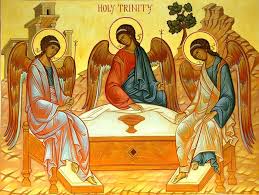 is Christ’s Offering to His Father, through the power of the Holy Spirit. See how in Rublev’s symbolic depiction of the Trinity, the Son and Spirit both incline towards the Father. Our words are all in second person plural, “we”, because this is our offering, all of us together. Indeed, even when we pray “in our closet” we never pray alone. We are the Church, His Body.
is Christ’s Offering to His Father, through the power of the Holy Spirit. See how in Rublev’s symbolic depiction of the Trinity, the Son and Spirit both incline towards the Father. Our words are all in second person plural, “we”, because this is our offering, all of us together. Indeed, even when we pray “in our closet” we never pray alone. We are the Church, His Body.
Have you considered how odd it is that in our prayers we tell God what He already knows? Saint Basil begins by praising Him as the “Existing One *, Master, Lord, God, almighty and adorable Father”. Surely God already is aware of this! so why do we tell Him? Actually most personal conversation consists not of imparting information but of “keeping in touch”. (When I tell my wife she looks lovely, as she almost always does but I so often forget to say it, I’ll bet she already knows that! How could she not?) For our soul’s salvation, for us even to truly live, we need to be in this loving personal relationship with God.
- Just in passing, do you know where that title “Existing One” comes from?
 (We hear it also in the dismissal at some services.) From Moses’ vision of God in the burning bush. Exodus 3:14 He asked “What is your name? What shall I tell my people?” God answered “I am who I am” or “I am the One who is.” or “…who exists.” Only God just “Is”. We exist “contingently”, only because He causes us to exist moment by moment.
(We hear it also in the dismissal at some services.) From Moses’ vision of God in the burning bush. Exodus 3:14 He asked “What is your name? What shall I tell my people?” God answered “I am who I am” or “I am the One who is.” or “…who exists.” Only God just “Is”. We exist “contingently”, only because He causes us to exist moment by moment.
Saint Basil proceeds: “It is truly meet and right and befitting the majesty of thy holiness that we should praise thee, hymn thee, bless thee, worship thee, give thanks unto thee and glorify thee.”
He says that we offer to the Father “rational worship” – or some translate it as “spiritual worship”. “Rational” means that we worship with our minds. Orthodox worship is not “feel good” worship; it has doctrinal content. If you want to know what Orthodox believe, come and hear and see our worship, and learn. “Spiritual” worship? Christ said to the woman of Samaria: “God is spirit, and his worshipers must worship in spirit [or “in the Spirit”] and in truth.” John 4:24
We offer this worship “in contrite heart and spirit of humility” – because of Who God is and who we are. The Old Testament Jews dared not even speak His Name. For “Who is able to speak of thy mighty acts, to make thy praises to be heard, or to tell of all thy wonders at every season?”
The Father is “Master of all, Lord of heaven and earth and of all creation both visible and invisible.” Sometime when you have a few minutes, take time to try and imagine the One Who always “Is”, who dwells in “light inaccessible Whom no one has seen or ever can see”,  the Creator of time and space, Who is present in and commands and orders and works in all things from the smallest sub-atomic particle to the farthest quasar, and behind the Big Bang (whatever that means) – and also in you. (But don’t think about this too hard or too often. It’s too much for us.) This is the One to Whom we pray. * We must approach Him with reverence and awe.
the Creator of time and space, Who is present in and commands and orders and works in all things from the smallest sub-atomic particle to the farthest quasar, and behind the Big Bang (whatever that means) – and also in you. (But don’t think about this too hard or too often. It’s too much for us.) This is the One to Whom we pray. * We must approach Him with reverence and awe.
- This is why cheap sentimental religion and worship just won’t do: “You really are a fisher of men, and, Baby, you just reeled me in”, “The great Scoutmaster in the sky”. Things like this are actually sung to God in some places.
++++++++++
This is no place to stop, but this Post is going on too long. Next Week Saint Basil will go on to praise the Son and the Holy Spirit (while still addressing the Father), and then we will be prepared to sing the Thrice Holy Hymn to the Three-Personed God.
But before that: Saint Basil, my patron saint, has always intimidated me. He was so brilliant and accomplished so very many things in so few years, while I in 81 years… … Now he’s doing it again. In trying to describe his Anaphora, I feel I’ve got in ‘way over my head. If I say anything heretical or stupid here, please correct me.

Great!